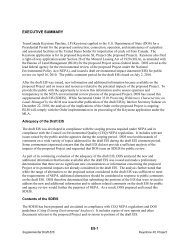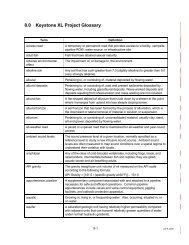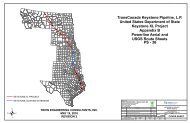2.1 Overview of the Proposed Project - Keystone XL pipeline - US ...
2.1 Overview of the Proposed Project - Keystone XL pipeline - US ...
2.1 Overview of the Proposed Project - Keystone XL pipeline - US ...
You also want an ePaper? Increase the reach of your titles
YUMPU automatically turns print PDFs into web optimized ePapers that Google loves.
Draft Supplemental Environmental Impact Statement<strong>Keystone</strong> <strong>XL</strong> <strong>Project</strong>The proposed <strong>Project</strong> is a modern <strong>pipeline</strong> built to higher standards than <strong>pipeline</strong>s built in <strong>the</strong>1950s. Fur<strong>the</strong>r, <strong>the</strong>re are a number <strong>of</strong> operational requirements for <strong>the</strong> <strong>Keystone</strong> <strong>XL</strong> Pipeline thatexceed current regulations; consequently, <strong>the</strong> <strong>pipeline</strong> is expected to operate at a higher level <strong>of</strong>safety than o<strong>the</strong>r <strong>pipeline</strong>s currently in operation. Finally, <strong>Keystone</strong> has stated its commitment to<strong>the</strong> prevention <strong>of</strong> incidents including using lessons learned from <strong>the</strong> entire industry to continue toimprove its <strong>pipeline</strong> safety programs.The publically available portion <strong>of</strong> <strong>the</strong> <strong>Keystone</strong> Oil Pipeline System ERP is included asAppendix I, SPCC and ERP (parts <strong>of</strong> <strong>the</strong> ERP and <strong>the</strong> PSRP are considered confidential byPHMSA and <strong>the</strong> U.S. Department <strong>of</strong> Homeland Security). As described in Section 4.13,Potential Releases, <strong>the</strong> existing <strong>Keystone</strong> Oil Pipeline <strong>Project</strong> documents would be used astemplates for <strong>the</strong> plans for <strong>the</strong> proposed <strong>Project</strong>. <strong>Project</strong>-specific information would be insertedinto <strong>the</strong> plans as it becomes available. In addition, response equipment would be procured andstrategically positioned along <strong>the</strong> route, staff would be trained in spill response and <strong>the</strong> IncidentCommand System, and emergency services and public <strong>of</strong>ficials would be educated on all aspects<strong>of</strong> <strong>the</strong> proposed <strong>Project</strong> and what <strong>the</strong>ir roles would be if an accidental leak were to occur. If aspill were to occur, <strong>Keystone</strong> and its contractors would be responsible for recovery and cleanup.PHMSA would require a certification from <strong>Keystone</strong> that necessary emergency responseequipment is available in <strong>the</strong> event <strong>of</strong> an unplanned spill prior to providing <strong>Keystone</strong> with anauthorization to begin operating <strong>the</strong> proposed <strong>Project</strong>.The specific locations <strong>of</strong> <strong>Keystone</strong>’s emergency responders and equipment would be determinedupon conclusion <strong>of</strong> <strong>the</strong> <strong>pipeline</strong> detailed design and described in <strong>the</strong> PSRP and ERP. Companyemergency responders would be placed consistent with industry practice and with applicableregulations, including 49 CFR Parts 194 and 195.The response time to transfer additionalresources to a potential leak site would follow an escalating tier system, with initial emergencyresponders capable <strong>of</strong> reaching all locations within 6 hours in <strong>the</strong> event <strong>of</strong> a spill for high volumeareas; <strong>the</strong> spill response for all o<strong>the</strong>r areas is 12 hours. Typically, emergency responders wouldbe based in closer proximity to <strong>the</strong> following areas:• Commercially navigable waterways and o<strong>the</strong>r water crossings;• Populated and urbanized areas; and• Unusually sensitive areas, including drinking water locations, ecological, historical, andarchaeological resources.<strong>Keystone</strong> contacted first responders along <strong>the</strong> mainline route as part <strong>of</strong> its stakeholder outreachprogram in advance <strong>of</strong> going into service. On an annual basis, at minimum, awarenessinformation materials are delivered to local level emergency service agencies including fire,police, 911, county emergency managers, and Tribal agencies along <strong>the</strong> <strong>Keystone</strong> route. Thisincludes operator information such as <strong>pipeline</strong> location, product awareness, how to recognize <strong>the</strong>signs <strong>of</strong> a leak, how to contact <strong>Keystone</strong>, and guidelines on how to respond. <strong>Keystone</strong> regularlypartners with <strong>the</strong> communities in which it operates and supports emergency responderdevelopment. This has included donations <strong>of</strong> fire truck rigging, rope rescue equipment, trailers,and air bag kits. Additionally, <strong>Keystone</strong> has jointly planned with emergency responders to storeequipment in strategic locations to facilitate an effective response. In select cases, <strong>Keystone</strong>would collaborate with dedicated hazmat teams to determine additional emergency responsetactics <strong>the</strong>y may undertake. Additional details can be found in Section 4.13, Potential Releases.<strong>Project</strong> Description <strong>2.1</strong>-72 March 2013











